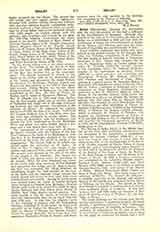

Belley (BELLICIUM), Diocese of, coextensive with the civil department of Ain and a suffragan of the Archbishopric of Besancon. Although suppressed at the time of the Concordat, the Diocese of Belley was reestablished in 1822 and took from the Archdiocese of Lyons the arrondissements of Belley, Bourg, Nantua, and Trevoux, and from the Archdiocese of Chambery the arrondissement of Gex.
Local tradition maintains that Belley was evangelized in the second century by the martyrs Marcellus and Valerian, companions of St. Pothinus. The first bishop of historic certainty is Vincentius, mentioned in 552. Others who occupied the see were St. Hippolytus, Abbot of Condat (eighth century); St. Anthelm (1163-78), seventh General of the Carthusian Order; St. Arthaud (1179-90), founder of the Carthusians at Arvieres; Camus (1609-29), a noted preacher and romancist; and Monseigneur Francois M. Richard (1872-75), later Cardinal and Archbishop of Paris. Belley honors in a special manner St. Amandus, Bishop of Maastricht, who founded the Abbey of Nantua about 660; St. Vulbas, a patrician of Bourgogne and a war companion of King Dagobert, treacherously assassinated in 642; St. Rambert, killed by order of Ebroin in the seventh century, whose name has been given to a city of the diocese; St. Trivier, the solitary, who died about 650; St. Barnard (ninth century), who founded the great Benedictine Abbey of Ambronay and died Archbishop of Vienna; St. Lambert (twelfth century), founder of the Cistercian Abbey at Chezery; St. Roland (twelfth century), Abbot of Chezery; St. Stephen of Chatillon, who founded the Carthusian monastery at Portes, in 1115, and died Bishop of Die; St. Stephen of Bourg, who founded the Carthusian monastery at Meyria in 1116; and St. Jean-Baptiste Vianney (1786-1857), parish priest at Ars.
The Diocese of Belley which, in the Middle Ages, had no less than eight Carthusian monasteries, was the birthplace of the Josephistes, a congregation founded by Jacques Cretenet (1606-67), a layman and surgeon who became a priest after the death of his wife; of the teaching order of the Sisters of St. Charles, founded by Charles Demia of Bourg (1636-89); and of three teaching orders founded in the first half of the nineteenth century: the Brothers of the Society of the Cross of Jesus; the Brothers of the Holy Family of Belley, and the Sisters of St. Joseph of Bourg. In 1858 a Trappist monastery was established in the unhealthy Dombes district. Cardinal Louis Aleman (1390-1450) and Soeur Rosalie (1787-1856), noted in the history of modern Parisian charities, were both natives of the Diocese of Belley. Blessed Pierre-Louis-Marie Chanel was born at Cuet near Bourg. For thirty years of its existence (1701-31), “Le Journal de Trevoux”, a valuable repertory of the literary and religious history of the period, was published by the Jesuits at Trevoux, in this diocese. The church at Brou, near Bourg, is a marvel of architecture and contains some wonderful pieces of sculpture. It was built between 1511 and 1536 under the direction of Margaret of Austria, widow of Philibert (II) the Fair, Duke of Savoy.
The latest statistics for the diocese give the following institutions: 1 maternity hospital, 66 infant schools, 1 deaf-mute institute, 3 boys’ orphanages, 10 girls’ orphanages, 21 hospitals, or hospices, 2 dispensaries, 21 communities for the care of the sick in their homes, 1 home for incurables, and 5 homes for the aged, all conducted by sisters; and 1 deaf-mute institute, and 2 insane asylums conducted by brothers.
In 1900 the following religious orders were represented in the Diocese of Belley: Carthusians, at Portes and Selignac; Trappists at Notre Dame des Dombes; Marists at Belley; Lazarists at Musiniens; and Fathers of the Blessed Sacrament at Trevoux. Congregations local to the diocese are: two teaching orders: the Brothers of the Society of the Cross of Jesus founded by M. Bochard in 1824, and the Brothers of the Holy Family, founded by Brother Taborin in 1835; and the Sisters of St. Joseph, with mother-house at Bourg, very numerous throughout the department. At the close of the year 1905 the Diocese of Belley contained 350,416 inhabitants, 36 parishes, 404 mission churches, and 75 curacies.
GEORGES GOYAU

